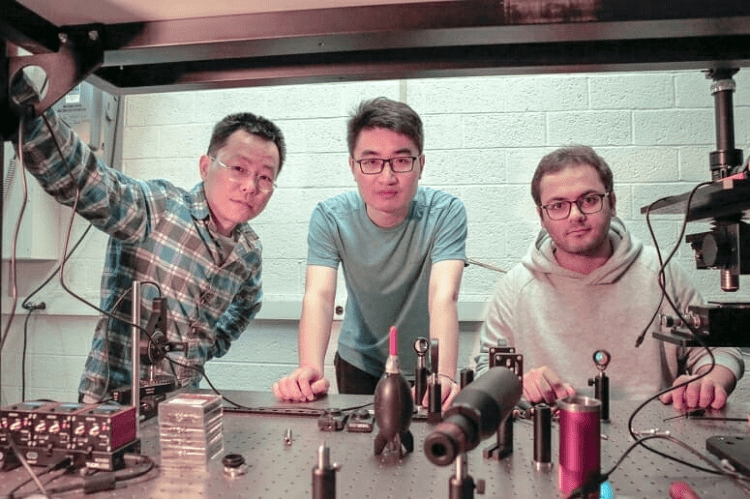Jul 9 2019
The advanced technology that drives face recognition in a number of contemporary smartphones may one day receive a technological upgrade that looks and sounds amazingly low-tech.
 From left to right, Zongfu Yu, Ang Chen, and Efram Khoram developed the concept for a “smart” piece of glass that recognizes images without any external power or circuits. (Image credit: Sam Million Weaver)
From left to right, Zongfu Yu, Ang Chen, and Efram Khoram developed the concept for a “smart” piece of glass that recognizes images without any external power or circuits. (Image credit: Sam Million Weaver)
This glimpse into the future is provided by a mere piece of glass. Now, engineers at the University of Wisconsin–Madison (UW-Madison) have developed a new technique for producing pieces of “smart” glass that is capable of recognizing images without needing any circuits, sensors, or power sources.
We’re using optics to condense the normal setup of cameras, sensors and deep neural networks into a single piece of thin glass.
Zongfu Yu, Professor, Department of Electrical and Computer Engineering, UW-Madison
Along with colleagues, Yu has recently reported the details of the proof-of-concept study in the journal, Photonics Research.
At first glance, the concept of integrating artificial intelligence within inert objects appears like something out of science fiction. Conversely, it is a development that can possibly pave the way for low-power electronics.
Currently, artificial intelligence consumes a great deal of computational resources (and thus battery life) each time a person looks at his or her phone to unlock it through face ID. In the coming days, a single piece of glass will be able to recognize a person’s face without utilizing any power at all.
“This is completely different from the typical route to machine vision,” stated Yu.
Yu imagines glass pieces that resemble translucent squares. Strategically placed tiny bubbles and impurities integrated inside the glass would bend light in certain ways to distinguish among diverse images. That is said to be the artificial intelligence in action.
The engineers, for their proof of concept, developed a new technique to fabricate pieces of glass that can recognize numbers written by hand. Light emerging from an image of a number gets in from one end of the glass, and subsequently focuses to one of the nine particular locations on the other side of the glass, with each corresponding to separate digits.
The glass was sufficiently dynamic to identify when a handwritten 3 was modified to become an 8, in real time.
“The fact that we were able to get this complex behavior with such a simple structure was really something,” stated Erfan Khoram, a graduate student in Yu’s laboratory.
Creating the glass to detect numbers was akin to a machine-learning training process, except that the researchers “trained” an analog material rather than digital codes. To be specific, the team placed different shapes and sizes of air bubbles and also tiny pieces of light-absorbing materials, such as graphene, at particular spots within the glass.
“We’re accustomed to digital computing, but this has broadened our view,” stated Yu. “The wave dynamics of light propagation provide a new way to perform analog artificial neural computin.g,”
Here, one such benefit is that the computation is fully passive and inherent to the material, which means a single piece of image-recognition glass can be utilized for an unlimited number of times.
“We could potentially use the glass as a biometric lock, tuned to recognize only one person’s face” added Yu. “Once built, it would last forever without needing power or internet, meaning it could keep something safe for you even after thousands of years.”
Moreover, the glass functions at exactly the speed of light, because it distorts light waves to differentiate among many different images.
While the up-front training process can be computationally demanding and time consuming, the glass itself can be developed in a simple and cost-effective manner.
In the coming days, the engineers will plan to find out whether their method would also work for more intricate tasks, for example, facial recognition.
The true power of this technology lies in its ability to handle much more complex classification tasks instantly without any energy consumption. These tasks are the key to create artificial intelligence: to teach driverless cars to recognize a traffic signal, to enable voice control in consumer devices, among numerous other examples.
Ming Yuan, Research Collaborator and Professor, Department of Statistics, Columbia University
Human vision is overwhelming general in its abilities to distinguish a countless number of diverse objects. By contrast, the smart glass can outshine in certain applications—for instance, a single piece of glass for recognizing numbers, a different piece for recognizing faces, another for letters, and so on.
We’re always thinking about how we provide vision for machines in the future, and imagining application specific, mission-driven technologies. This changes almost everything about how we design machine vision.
Zongfu Yu, Professor, Department of Electrical and Computer Engineering, UW-Madison
The study also involved graduate students Dianjing Liu and Ang Chen from UW–Madison, and Qiqi Wang from the Massachusetts Institute of Technology.
A Young Faculty Award grant from the Defense Advanced Research Projects Agency supported the study.
Simple 'smart' glass reveals the future of artificial vision
(Video credit: University of Wisconsin-Madison)